My Story of 3D Realms / Apogee Part I
NOTE: This article is spread out over 8 pages. It used to be one, but it grew too large – WordPress doesn’t like single articles that are over 30,000 words long. There are navigation arrows at the bottom of each of the pages of this story. Make sure and check ’em all out.
![]()
 Those who know me (and have read my blog over the years) know that I spent quite some time working for Scott Miller & George Broussard of Apogee Software (later 3D Realms). Was probably the single most fun job I’ve ever had in my life, and to this day, I still wish the old team was together. I’m not getting into the why of that, just pointing out what happened in the past. I worked there from Dec of 1992 through May of 2009. I’ve talked about that part of my life in more detail elsewhere on this blog. That’s not why I’m writing today. I’m writing about the history of the company.
Those who know me (and have read my blog over the years) know that I spent quite some time working for Scott Miller & George Broussard of Apogee Software (later 3D Realms). Was probably the single most fun job I’ve ever had in my life, and to this day, I still wish the old team was together. I’m not getting into the why of that, just pointing out what happened in the past. I worked there from Dec of 1992 through May of 2009. I’ve talked about that part of my life in more detail elsewhere on this blog. That’s not why I’m writing today. I’m writing about the history of the company.
 Apogee was founded back in 1987, and still exists today, although the path to get from then till now has a lot of twisty, confusing bits. I always meant to lay this out, but the current incarnation of the company did a really cool “Realms Deep” thing last month, so I thought I’d get around to doing this historical piece. Back in the day I was the company archivist, and moreso than anyone else there I seemed to care more about the legacy and history of the company. So that’s what I’ m doing today. Diving into the history of the company that I was a customer for, worked at for almost 17 years, and still maintain a relationship with today.
Apogee was founded back in 1987, and still exists today, although the path to get from then till now has a lot of twisty, confusing bits. I always meant to lay this out, but the current incarnation of the company did a really cool “Realms Deep” thing last month, so I thought I’d get around to doing this historical piece. Back in the day I was the company archivist, and moreso than anyone else there I seemed to care more about the legacy and history of the company. So that’s what I’ m doing today. Diving into the history of the company that I was a customer for, worked at for almost 17 years, and still maintain a relationship with today.
 A side note: I started writing this as Realms Deep was still going on (5 Sep), and I didn’t release this until early November, so it took far longer to put together than I thought it would – ha!
A side note: I started writing this as Realms Deep was still going on (5 Sep), and I didn’t release this until early November, so it took far longer to put together than I thought it would – ha!
One final comment before I get into it. This is my personal thoughts and observations. This isn’t meant to be an official document for Apogee Software Ltd / 3D Realms. This is me looking back on everything. With that out of the way….
(The spinning logos are leftover images from our 1990’s website designs. Also, all the contents of this article are © 2024 Joe Siegler except for game screenshots and trailers.)
ADMIN NOTE: In Jan 2023, this blog post became a problem for my site. It was 33,000+ words in a single entry. When I wrote it in 2020, I did have some problems with the size, but it worked on the front end (even if I did have problems on the back end). Now as my site has grown, it can’t process the thing in one giant piece on the front end, so I had to break it down into several smaller parts. This first one is in the same spot as full size original. No content has been changed, just broken up into smaller pieces to help with the blog being able to render the pages! There will be navigation links on the subsequent pages.
Some Personal Stuff

I originally started work for Apogee on 14 Dec 1992. I’ve told this story elsewhere before, but my first association with Apogee was as a BBS operator back in Philadelphia. I used to have a BBS named “The Arsenal of Freedom” (first on Apple //, then on PC – both named after an old episode of Star Trek: The Next Generation). The PC version would distribute Apogee shareware, as it was very popular at the time. I was a customer, and bought many Apogee games from this era myself (Secret Agent, Commander Keen, the original Duke Nukem, etc…) Once Wolfenstein 3D came out (which I also bought), there was a version that came out that claimed to be a “new porn update for Wolf3D”. I alerted Scott Miller to that, and it was removed, and not long after that, Scott asked me if I wanted to be a beta tester for Apogee. I of course immediately said yes. During this time, the first ever employee hired by Apogee (other than Scott’s family) decided to leave Apogee. This was Shawn Green, who left Apogee to go to id Software. Scott asked in the beta group if anyone wanted to come work for Apogee, and I jumped on it. After a few chats, I decided to move from Philadelphia to Dallas to work for Apogee. I was working for AT&T at the time, so jumping halfway across the country to work for a company with about 20 employees from a place with about 70,000 was a major culture shock. After a time, I realized I was there to replace “Employee 1”, so I go WAY back. In those earliest days, I did phone support, which could be a challenge at times (RIP Debbie Flowers). I was on phones to have me learn the products, and then I moved into online support.
Something interesting, in looking for a document for another part of this article, I happened upon the original message that Scott Miller posted in the Apogee beta group asking if anyone wanted to come down to Garland and work for Apogee. I kept it, although it’s not in the greatest shape almost 30 years later. The message wasn’t dated, but it would have been early fall, as I was formally hired in October, had another trip to Texas in November, and moved permanently in early December. If you want to see the letter that got me to move 1,400 miles away to work for Apogee, I’ve taken a pic of it. You can click it for a larger version, which is easier to read.
Anyway, once I got there, I noticed a few of the things in place then were in a disorganized state. That’s not to say the company was a mess, but certain areas that I had direct responsibility over were. I was always one for organization and record keeping – even back then. One of the first things I did was organize the online distribution files. I don’t know how many of you reading this were around back then, but in early 1993, the distribution method for video game shareware (something pioneered by Scott Miller) was a bit of an odd distribution. There were many hub BBS’s around – the home one for Apogee was then Software Creations. They weren’t the only ones by far (others like Exec-PC come to mind), but all the shareware from before my time there from Apogee was a hodgepodge of various compression formats (both arj, pkzip, and arc), versions, and the like. I organized all of it, collected the entire distribution line, repackaged them into a uniform format, and made sure things were kept up to date with the latest compressions to make the files as small as possible. Having the official product line all line up and look the same in terms of compression, naming, and whatnot was something I thought it should be. Thought it looked better that way.
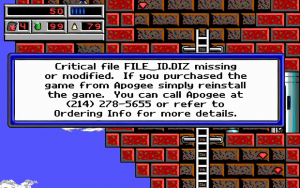
Back in those days, I did something which is commonplace now, but in 1993, it was unheard of. Scott & George decided they wanted someone to be what is now known as a “Community Manager”, but back then nobody did this. They pioneered online support, too. The person doing that online support was me. Things were different then, because there was no social media. We had things like CompuServe, GENie, Prodigy, Delphi, etc… If you were super techy (like John Carmack), you had .plan files – the precursor to twitter, in some ways. But it was my job to “be Apogee” online. It was a dream job.
I also introduced the old concept of “file_id.diz” to the Apogee distribution files. I didn’t create the format, but I did introduce it to our company in a unified format. We did have it in one or two games before I started, but it wasn’t consistent. The version I introduced had a similar format across all our games. It was also my idea to use file_id.diz as an early form of DRM on our registered games (to the consternation of some). My idea was this – if we had problems with people uploading the full/commercial versions of our games to BBS’s, I thought we could stick a file_id.diz in the full game directory, so if someone zipped it up and uploaded it, the BBS would then add the description that it was an illegal upload to the BBS listing and presumably be seen and removed. You couldn’t remove the file_id.diz file from commercial games, because the game would no longer run without that. Don’t know how many of you remember this about the Apogee games from back then, but this was totally my idea.
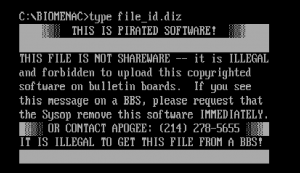
One of my other ideas then was to index the company’s output. Now back in 1993, we didn’t have a website yet (that started in the summer of 1995). However, everything that the company released from the moment I started working there I kept track of (with one or two exceptions that slipped through the cracks). Major releases, point releases, all updates, freeware, etc… I maintained that file until the day 3DR and I separated in 2009. I also kept track of it PAST my end of employment, and continued to updated it. It’s still maintained to this day (by me). That’s something I’m quite proud of. It has turned into a true historical document that I’ve been told people have used when researching our game history. The original is still available online, but what I’m doing with this blog post is expanding on the original basic list of games and dates. There will be additional info, like personal remembrances, screenshots, current availability, etc….

I was also the guy who uploaded all new shareware releases and patches. As is well known, our distribution network was housed at Software Creations, the major BBS run out of Massachusetts. However, they weren’t the only place. When we released something, I would spend a lot of time uploading our files to various major BBS’s around the country, so the packaging and distribution of our shareware was a big thing to me. FTP was also a thing around then, so I handled that too. I was the person who mastered floppy discs (and later CD’s) for mass duplication. Most of our CD’s had a /goodies directory on them – the majority of the time, I would gather random things and just throw them on the CD to have some other fun stuff to discover. That was all me. There’s a pic to the right of me holding the Fedex box in my office with the gold master CD for Shadow Warrior in 1997. There was a very famous picture of George Broussard in my office pointing at my computer on the first actual upload of Duke Nukem 3D to Software Creations on 29 Jan 1996. I’m sure you’ve seen it. I took that picture, too. ;)

Two other fun things I did with the 3D Realms site back in the day which were mostly unheard of at the time were the Virtual Tour, and the webcam. While the virtual tour is available on old copies of the 3D Realms website at archive.org, it doesn’t include the pictures, so it’s not something that’s worth seeking out. It’s not like a Virtual Reality tour in 2020. This was just a bunch of still pictures that you went to the next one by clicking something and it would load another page. Primitive tech by today’s standards, but nobody else was doing this in 1998 on the web. I had a fun easter egg in the tour, too. If you remember the old Infocom game “Zork”, there was a phase “It is dark, you are likely to be eaten by a grue”. Well, if you went into that area in the game, you were stuck in a maze. In my virtual tour, I mapped out that grue maze and replicated it. If you went down the wrong side of the offices, you’d get stuck in my grue maze in the tour. Always got a laugh out of that. Somewhere I have the actual hand drawn map I used to lay it out, but I couldn’t find it in prep for this article.
UPDATE 9 May 2022: Today I found the virtual tour scratch work including the Zork maze. I threw a few images on Twitter. You can see that tweet here, or view the images here, here, and here.
The webcam was a live camera – again not like 2020 standards, but it did have regularly updated photos. What I did was take a 1990’s era camcorder, and set up software on a specific machine which would take a still shot from the webcam once every 30 seconds. It would then FTP the image to our web server, overriding the existing photo, so the website would see the new one instead of the old one. Again, old tech, but nobody was really doing that in 1996. That camera got moved around a bunch, and we put it where things were going on. It lived in the lunch room for awhile, in tech support, in some of the developer’s offices, and we would sometimes use it to send messages to developers we were hiring (go look at the webcam, Martin!) – haha. However, the one most people remember was we put it in the room we shipped Duke Nukem 3D orders out of, so people could watch us packing orders. Sometimes it would crash too, and you’d end up with weirdness. I’ve included a couple of examples from both the tour and the cam in the gallery below.
One last one was something I did on the 3DR website for over a decade. That’s the “Camera Captioning Contest”. I’d post random goofy pictures taken around the offices, have people send in their ideas for a caption, and the winner would get a free game sent to them. Was a lot of fun – all the old entries and winners are still online, too. The contest ran from Dec 20, 1996 through Jan 12, 2006. It was revived for a time on social media with the new 3D Realms, but it didn’t last terribly long. Fun memory from the past, too.

I’ve written about my time at Apogee many times on this blog, and there’s some good stories to read if you want a deeper dive. Some of them are game specific, and I’ll link to them in the relevant game sections below. Some of the less game specific ones here are..
- Pearle Scarboro – My meeting with the mother of the late 3DR programmer William Scarboro.
- Happy Trails Duke Nukem – This was something I wrote on the last day that 3D Realms had the rights to Duke Nukem on 31 Dec 2015, it was about Duke Nukem in general.
- Duke Nukem Swag – A detail of all the various bits of Duke Nukem swag I had collected over the years. It’s not about any one game, so I’m listing it here. I also threw in my much smaller collection of Shadow Warrior stuff too.
- Nuking a Lobby Floor – A story about the creation and later destruction of the really badass looking lobby floor we had in the NW Highway 3D Realms Offices.
- Goodbye Duke Nukem – This is a very personal journey that I wrote on the last day I was working for Gearbox. At the time I thought it was the end of my connection to Apogee, 3D Realms, & Duke Nukem.
The Name
Before I get to the timeline of releases, I wanted to speak for a minute about the names “Apogee Software” & 3D Realms. There’s been a bunch of confusion over that over the years. I’ve explained it from time to time, but never put it down in blog form, so here goes.
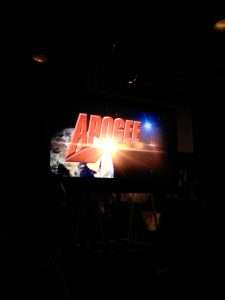
Back in 1987, Scott Miller founded Apogee Software. Kroz is generally regarded as the first “Apogee” game, and it was released in November 1987. There were a few rogue games that Scott used the name Apogee before then, but 1987 is more or less when the “company” was founded, because that was the first game that used “The Apogee Model”. Those earlier games (which I’ll detail below) were released differently. Anyway, back in those days, things were small. It was just Scott and his family in his parents’ house in Garland. A couple of years ago I wrote a story about that original location for the 3D Realms site. You can read it here. (Never did get around to writing the other parts).
A couple of years after that, George Broussard was brought on, things expanded, the company got larger, and while it was still before my time there, they created “Apogee Software Ltd.” That was (and still is to this day) the legal name of the company I worked for for almost seventeen years in the 90’s and 2000’s. “Apogee Software Ltd” was what was on my paychecks.
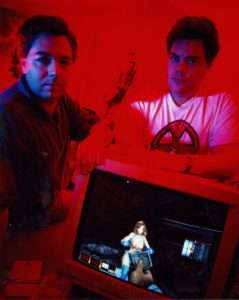 Some time after that, they also created another company called “Action Entertainment Inc”. Action Entertainment legally owned Apogee Software Ltd. The idea being if someone sued the company, they’d be suing AEI, and not Apogee (and therefore its employees) directly.
Some time after that, they also created another company called “Action Entertainment Inc”. Action Entertainment legally owned Apogee Software Ltd. The idea being if someone sued the company, they’d be suing AEI, and not Apogee (and therefore its employees) directly.
In 1994-ish, Scott Miller had the idea that we needed branded names. His stated idea at the time was that with the name “Apogee” had become diluted, and you didn’t know what type of game you would get when you got an Apogee game. I personally thought it was fine the way it was, but we ended up creating the 3D Realms name here out of this. Officially, 3D Realms is a “dba” name (doing business as), but after the release of Terminal Velocity, and then Duke Nukem 3D, the 3D Realms name took a front seat.
In 1996, we released the final game under the Apogee name – Stargunner. We used the 3D Realms name exclusively after that to identify ourselves, but legally we were still “Apogee Software, Ltd” (a name that still exists in 2020). We also had a second dba name around this time, that being “Pinball Wizards”, but only one game (Balls of Steel) was ever released using this name.
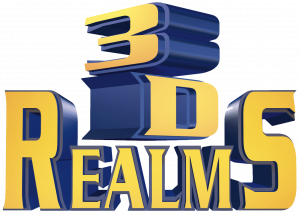
As was written about elsewhere, in 2009, the original Apogee (dba 3D Realms) ceased to exist as development studio, and laid off all their staff (including me). However, despite popular belief, Apogee/3D Realms never ceased to exist – ever. They remained in their offices through the beginning of 2011, then had offices in the Gearbox Software building in Plano TX for a time. Apogee/3D Realms continued to exist to maintain various intellectual properties they owned, but no active development was going on during this time.
Fast forward to 2014, when the original Apogee was sold to Interceptor Entertainment (now known as Slipgate) and moved the headquarters from Texas to Denmark. That is how it was presented to the public, but legally, “Apogee Software Ltd (dba 3D Realms)” was sold to “SDN Invest ApS” – a holding company that itself was owned by another holding company (MDN Holding ApS) who also owns Interceptor/Slipgate. The holding company is owned by the same people that run both 3D Realms and Slipgate, so this is similar to what Scott & George did years ago with “Action Entertainment Inc” (which is still legally in play, btw). Somewhere between the original purchase and now, The “SDN Invest ApS” holding company was shifted to a newer holding company, named “3D Realms Entertainment ApS” – who is also owned by “MDN Holding ApS”.
I realize all the holding company stuff is confusing, so…. the bottom line is as of 2020, the original Apogee Software still technically exists. Here goes…
The “name summary”…
Apogee Software Ltd is a wholly owned subsidiary of Action Entertainment Inc. Apogee Software Ltd has two dba’s – “3D Realms” & “Pinball Wizards”. Action Entertainment Inc, and all its assets are owned and controlled by “3D Realms Entertainment ApS”. 3D Realms Entertainment ApS is owned partly by MDN Holding ApS and partly by Slipgate Holding ApS.
Still confused?
To simplify that even further….. “The guys that own Slipgate/Interceptor also owns 3D Realms”. That’s the bottom line. ;)
I miss the days back when I started working at Apogee when it was just “Apogee Software” and nothing else. It was less confusing for sure. :)
Also… In April of 2021 a “New Apogee” came into existence. I don’t have anything to do with this version, although I know most everyone who works there.. It’s headed by Scott Miller, who founded the original (the original legally is 3D Realms in Denmark now). I have a short section about this version further down towards the end of this article. This new Apogee refers to itself as “Apogee Entertainment“, and in some places I also call them “Apogee Software LLC” – they’re the same thing.

The Game History
Now I get to the history of the individual games. As I posted above, there is a straight linear list of the release history for Apogee/3D Realms on the Legacy 3D Realms site. I always wanted to expand on that and make it a bit more intersting than a straight list. That’s what I’m doing here. This will have some screenshots, links, info to current stuff and remakes (when relevant), and my own memories of that title (assuming I have some). The original list had them in chronological order, and for the most part that will happen here, but the initial release and all the point releases will be mentioned in the same place there vs a straight list in the original. I was around for the majority of this stuff personally, and for the stuff I wasn’t, I know just about everyone involved. So here goes…
ADMIN NOTE: A lot of links on this listing of games are FTP links to the original Apogee (later 3DR) FTP archive I maintained for the better part of 20 years. All that stuff still works, however.. Most modern browsers these days (Safari, Chrome etc), disallow FTP links, so you can’t directly access them in your browser, you’ll need an actual FTP client to download them, but they ARE still there. And those of you who are fans of rogue browsers like Mullvad, Vivaldi, and Arc… I know those exist, some do work with FTP links, but I’m not creating a sub article on modern browser functionality. Basically if you click on one of the FTP links in this article, and it doesn’t work, that’s why – you’ll need an FTP client.

While the generally established history has the first proper Apogee game in the fall of 1987, there was some activity before then. A handful of titles were released earlier, not using the same “Apogee model” that the company became known for. The true release dates of these 1986 releases is lost to time. Unfortunately, none of us really remember what the proper dates are now. If for some reason you happen to have verifiable info proving the date of any of them, please let me know.
The Puzzle Fun Pack
This was a “pack” of four small puzzle games all written by Scott Miller. The individual titles were Asteroid Rescue, Block, Five, Maze Machine & Phrase Master. Was discontinued ages ago, but is available as freeware from our FTP site.
By the time I found out this existed, I was already working for Apogee, and computers were already too fast for this game. A lot of these early games didn’t adapt themselves to faster computers than they were designed on, and as such are instantly unplayable. The same goes for the next entry on the list here.
Current Status: Freeware
Puzzle Fun Pack Links: [ Freeware – 3DR FTP | Internet Archive ]

The Adventure Fun Pack
Another “pack” of four small games all written by Scott Miller. The individual titles were Night Bomber, Raiders of the Forbidden Mine, Rogue Runner, and The Thing. The one I have a screen shot from here is “Raiders of the Forbidden Mine”. It really reminds me of Dig Dug. Other than researching for this article, I’ve never played any of these games, although I was aware of their existence.
This has the same speed problem with modern computers that the entry before this does. Was discontinued ages ago, but is available as freeware from our FTP site.
Current Status: Freeware
Adventure Fun Pack Links: [ Freeware – 3DR FTP | Internet Archive ]

Beyond the Titanic
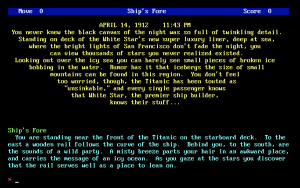
Release Date: Unknown 1986
Beyond the Titanic was a text adventure game in the vein of the original Zork games written by Scott Miller. If you liked the old Infocom games, you probably would like this. It still holds up in 2020, as it’s a text adventure game, so there’s no speed problems or graphics issues with modern computers.
Here’s the actual text for Beyond the Titanic from one of our super ancient catalog files we would distribute with games.. “It’s a text adventure game that mixes elements of science fiction, action, fantasy and rollicking adventure. The story begins with you standing aboard the Titanic just seconds before the ship sinks! In this story of riveting survival you’ll discover a long forgotten undersea mystery, travel to the Earth’s future, fly a shuttle to a floating city and be chased by a slobbering, three-armed creature–and that’s just the believable part!”
Was discontinued a long time ago. Re-released as freeware on 10 Mar 1998. Re-released a second time as freeware, only with the source code on 20 Mar 2009. Still available on the 3D Realms FTP site.
Current Status: Freeware
Beyond the Titanic Links: [ Freeware – 3DR FTP | Internet Archive ]

Supernova
We released another text adventure game similar to the prior year’s Beyond the Titanic. this one was called “Supernova”. Supernova was written by Scott and his friend Terry Nagy. Between Supernova & BTT, Scott learned that releasing the entire game in shareware was not the way to go, and a new concept was needed, and what the company became known for (“The Apogee Model”) was born with the next release. However, like Beyond the Titanic before it, Supernova will appeal to fans of the old Infocom text adventure games.
Here’s the actual text for Supernova from one of our super ancient catalog files we would distribute with games.. “Our best adventure game requires an entire 360K disk! Has as many features as even the best commercial adventure games, and then some. Like a 16-color screen, ASCII graphics (that even work on nongraphic systems), 1000+ word dictionary, over 160 game locations, scores of sound effects, a “hint” command, and more.”
The game was discontinued ages ago. Was released as freeware on 26 Mar 1998. Later re-released again as freeware with source code on 20 Mar 2009. It is still available on the 3D Realms FTP site.
Current Status: Freeware w/Source Code
Supernova Links: [ Freeware – 3DR FTP | Internet Archive ]

Kroz
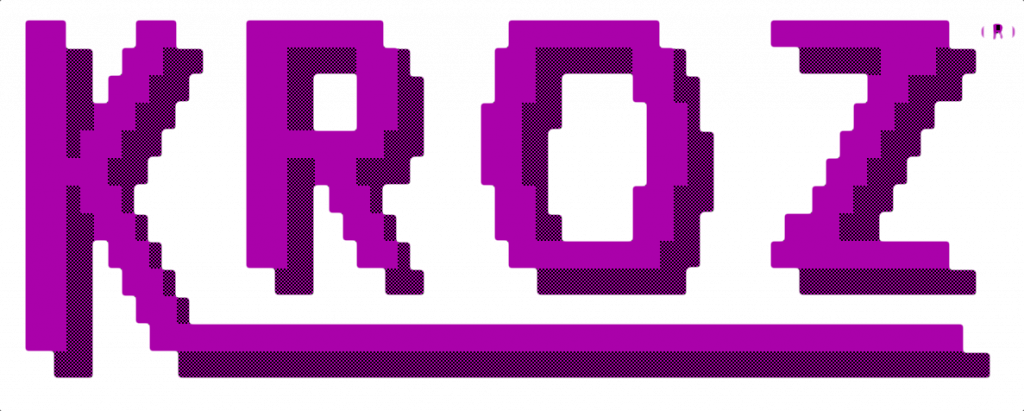
 Release Date: 26 Nov 1987
Release Date: 26 Nov 1987
This is where Apogee starts formally. That’s because it was the first game to use “The Apogee model” where the first episode was given away for free, and the rest had to be paid for – aka “shareware”. Scott did a a total of 7 Kroz episodes, and this is the bulk of the early product for Apogee from this point for the next year or so. Here’s some detail on the 7 episodes:
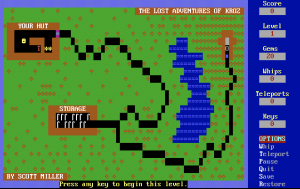 Kingdom of Kroz (1987)
Kingdom of Kroz (1987)- Caverns of Kroz (1988)
- Dungeons of Kroz (1989)
- Return to Kroz (1990)
- Temple of Kroz (1990)
- Final Crusade of Kroz (1990)
- The Lost Adventures of Kroz (1990)
The first three were packaged as “The Kroz Trilogy”, and the second three as the “Super Kroz Trilogy”. There was to be 8th episode of Kroz released in 1991 (The Underground Empire of Kroz), but it was never released. I asked Scott in the creation of this article how much he’d actually done towards the 8th Kroz, and he said “I think I did a few little things but no actual levels.” So there’s no lost game waiting to be found.
There’s some additional detail on the Kroz games over here on Wikipedia. Some of the Kroz games had alternate names, too (such as Dungeons of Kroz being called “Kroz II”) – all of that is on the Wikipedia page. In researching this article I found something we used to distribute, a document called “Kroz: The Entire Domain”, detailing the episodes, their original prices, and some other info. It is shown below.
At the time it was new, the source code was available for an additional purchase. All of the various Kroz games were discontinued ages ago, but were re-released as freeware (with source code) on 20 Mar, 2009.
Current Status: Freeware w/Source Code
Kroz Links: [ Freeware – 3DR FTP ]



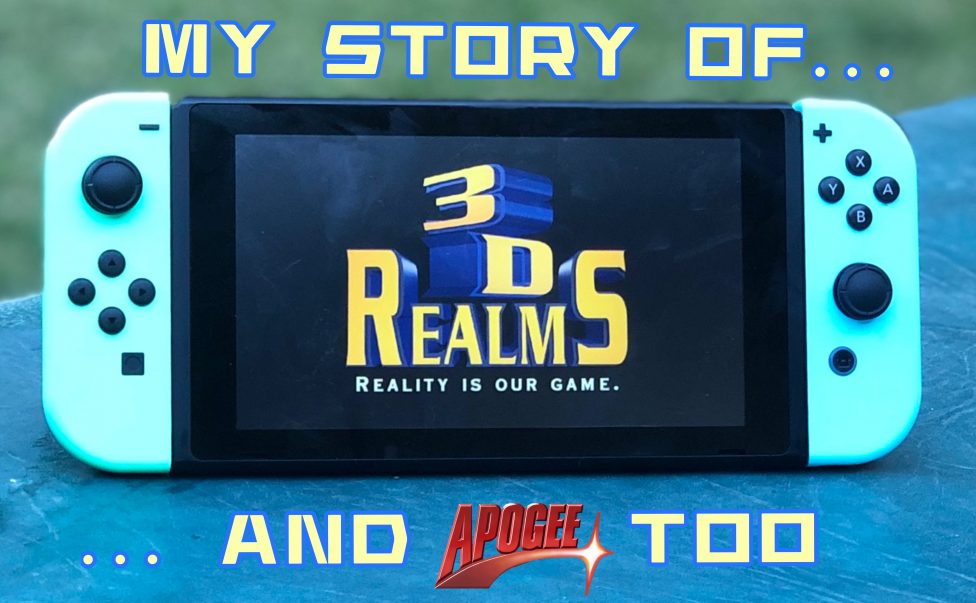
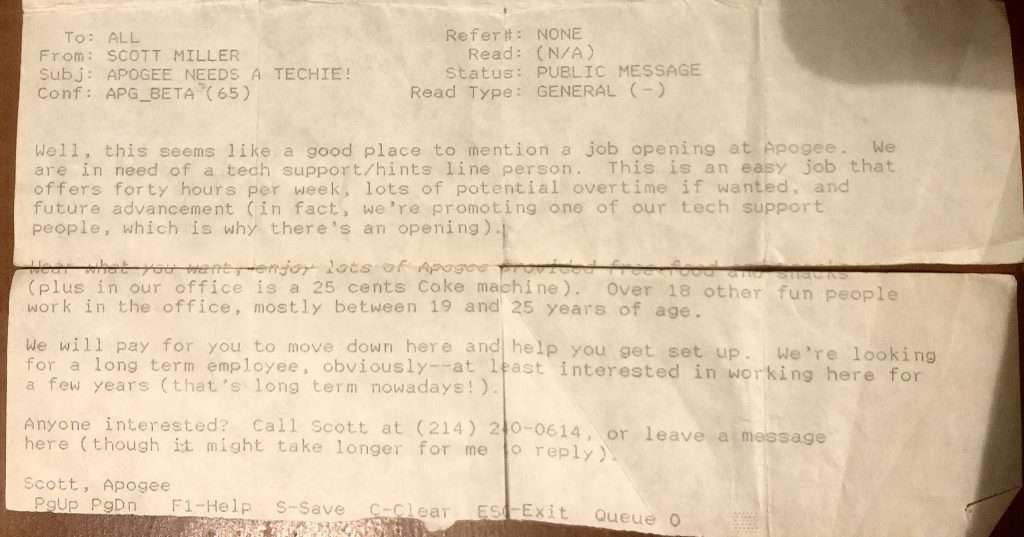



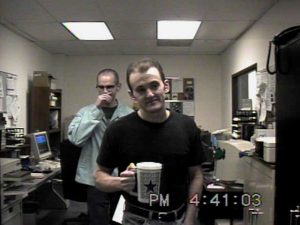
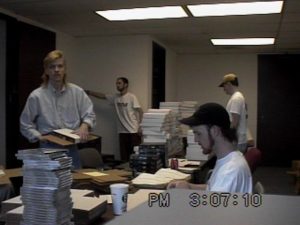

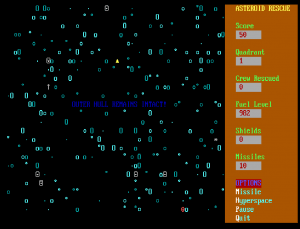
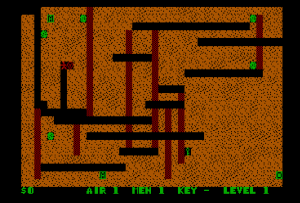
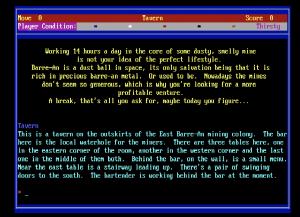
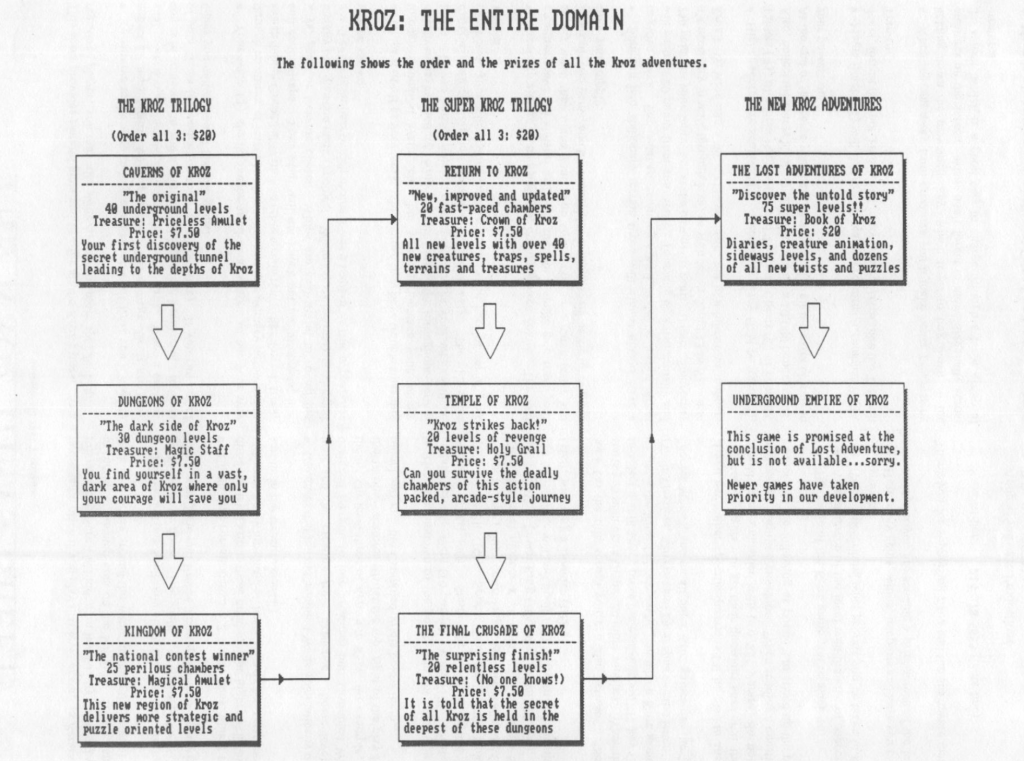

Join the Conversation
Woah. Long article. My SeaMonkey v2.53.4 web browser, in my decade old updated 64-bit W7 HPE SP1 PC, struggled to load this web page. :(
A trip down memory lane, I had forgotten how much time I devoted to obtaining from shareware distributors and BBSs each new title as they came out, starting from the Kroz era. Then, as this post was written, I was busy replaying Kroz for my own gaming blog — perfect timing, or you were spying on me? I’m not sure. Thanks for the research and record-keeping.
Duke Nukem 3D was one of the first PC games I played as a child. I still remember how intense it was for me back then; loved every minute of it.
Thank you for your work building these games, and for the blog post. It brings back some fond memories.
Duke Nukem: Gameboy Color is not a port of Duke Nukem II. While it shares a similar plot both games have very little in common besides both of them being side-scrollers. Same with Duke Nukem Advance while the graphics are similar to 3D the game itself is original.
Super great post, thanks Joe ? I was one of the old 3drealms forum people many lightyears ago, when we waited on DNF. Great to get some more insights and read all about it. Would also love some more details behind everything (especially Duke and original Prey).
Hello Joe,
I created the Extreme Rise of the Triad guide a few years ago, which I linked you to back then. Recently, I livestreamed the game and it’s up on my Youtube. With civvie’s recent video, it finally got me to do something like this. I played on the hardest difficulty, without cheats, and without frequent saves, to show how to beat Extreme ROTT. It’s the first time I picked this game back up since about 3 years; so it’s a semi-blind run (ie, without practice, refreshers or even consulting my own guide for anything I forgot). If you’re curious, you can search Extreme Rise of the Triad casual playthrough, you should find the playlist for it, by JosephWJ.